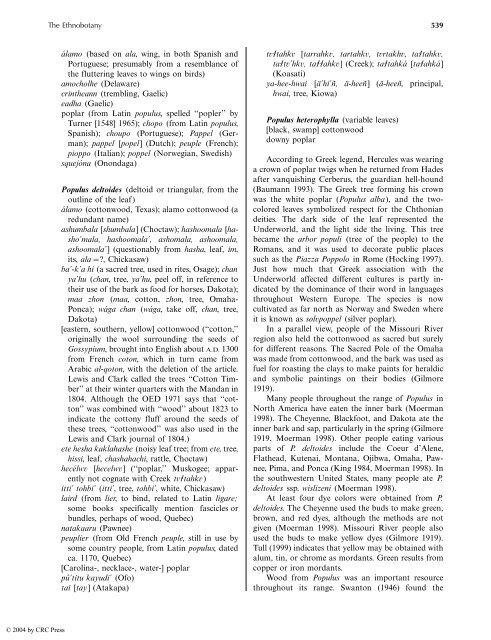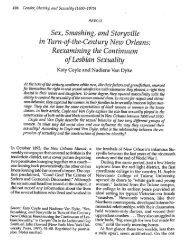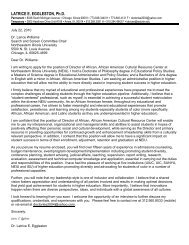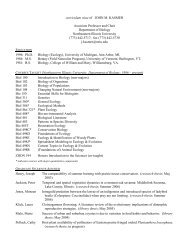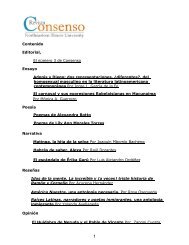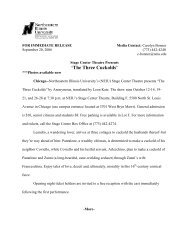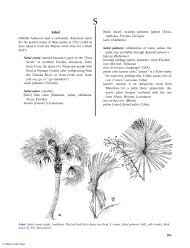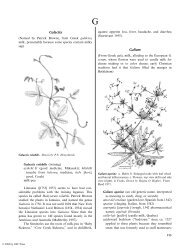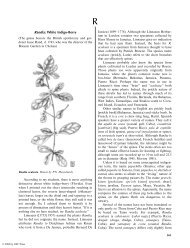Herba Cana - Northeastern Illinois University
Herba Cana - Northeastern Illinois University
Herba Cana - Northeastern Illinois University
Create successful ePaper yourself
Turn your PDF publications into a flip-book with our unique Google optimized e-Paper software.
© 2004 by CRC Press<br />
The Ethnobotany 539<br />
álamo (based on ala, wing, in both Spanish and<br />
Portuguese; presumably from a resemblance of<br />
the fluttering leaves to wings on birds)<br />
amocholhe (Delaware)<br />
crintheann (trembling, Gaelic)<br />
eadha (Gaelic)<br />
poplar (from Latin populus, spelled ‘‘popler’’ by<br />
Turner [1548] 1965); chopo (from Latin populus,<br />
Spanish); choupo (Portuguese); Pappel (German);<br />
pappel [popel] (Dutch); peuple (French);<br />
pioppo (Italian); poppel (Norwegian, Swedish)<br />
squejóna (Onondaga)<br />
Populus deltoides (deltoid or triangular, from the<br />
outline of the leaf)<br />
álamo (cottonwood, Texas); alamo cottonwood (a<br />
redundant name)<br />
ashumbala [shumbala] (Choctaw); hashoomala [hasho’mala,<br />
hashoomala’, ashomala, ashoomala,<br />
ashoomala’] (questionably from hasha, leaf, im,<br />
its, ala /?, Chickasaw)<br />
ba’-k’a hi (a sacred tree, used in rites, Osage); chan<br />
ya’hu (chan, tree, ya’hu, peel off, in reference to<br />
their use of the bark as food for horses, Dakota);<br />
maa zhon (maa, cotton, zhon, tree, Omaha-<br />
Ponca); wága chan (wága, take off, chan, tree,<br />
Dakota)<br />
[eastern, southern, yellow] cottonwood (‘‘cotton,’’<br />
originally the wool surrounding the seeds of<br />
Gossypium, brought into English about A.D. 1300<br />
from French coton, which in turn came from<br />
Arabic al-qoton, with the deletion of the article.<br />
Lewis and Clark called the trees ‘‘Cotton Timber’’<br />
at their winter quarters with the Mandan in<br />
1804. Although the OED 1971 says that ‘‘cotton’’<br />
was combined with ‘‘wood’’ about 1823 to<br />
indicate the cottony fluff around the seeds of<br />
these trees, ‘‘cottonwood’’ was also used in the<br />
Lewis and Clark journal of 1804.)<br />
ete hesha kaklahashe (noisy leaf tree; from ete, tree,<br />
hissi, leaf, chashahachi, rattle, Choctaw)<br />
hecélwv [hecelwv] (‘‘poplar,’’ Muskogee; apparently<br />
not cognate with Creek tvɬ tahkv)<br />
itti’ tohbi’ (itti’, tree, tohbi’, white, Chickasaw)<br />
laird (from lier, to bind, related to Latin ligare;<br />
some books specifically mention fascicles or<br />
bundles, perhaps of wood, Quebec)<br />
natakaaru (Pawnee)<br />
peuplier (from Old French peuple, still in use by<br />
some country people, from Latin populus, dated<br />
ca. 1170, Quebec)<br />
[Carolina-, necklace-, water-] poplar<br />
pû’titu kayudi’ (Ofo)<br />
tai [tay] (Atakapa)<br />
tvɬ tahkv [tarrahkv, tartahkv, tvrtakhv, taɬ tahkv,<br />
taɬ tv’hkv, taɬɬahkv] (Creek); taɬ tahká [taɬ ahká]<br />
(Koasati)<br />
ya-hee-hwai [ä’hi’ñ, ä-heeñ] (ä-heeñ, principal,<br />
hwai, tree, Kiowa)<br />
Populus heterophylla (variable leaves)<br />
[black, swamp] cottonwood<br />
downy poplar<br />
According to Greek legend, Hercules was wearing<br />
a crown of poplar twigs when he returned from Hades<br />
after vanquishing Cerberus, the guardian hell-hound<br />
(Baumann 1993). The Greek tree forming his crown<br />
was the white poplar (Populus alba), and the twocolored<br />
leaves symbolized respect for the Chthonian<br />
deities. The dark side of the leaf represented the<br />
Underworld, and the light side the living. This tree<br />
became the arbor populi (tree of the people) to the<br />
Romans, and it was used to decorate public places<br />
such as the Piazza Poppolo in Rome (Hocking 1997).<br />
Just how much that Greek association with the<br />
Underworld affected different cultures is partly indicated<br />
by the dominance of their word in languages<br />
throughout Western Europe. The species is now<br />
cultivated as far north as Norway and Sweden where<br />
it is known as sølvpoppel (silver poplar).<br />
In a parallel view, people of the Missouri River<br />
region also held the cottonwood as sacred but surely<br />
for different reasons. The Sacred Pole of the Omaha<br />
was made from cottonwood, and the bark was used as<br />
fuel for roasting the clays to make paints for heraldic<br />
and symbolic paintings on their bodies (Gilmore<br />
1919).<br />
Many people throughout the range of Populus in<br />
North America have eaten the inner bark (Moerman<br />
1998). The Cheyenne, Blackfoot, and Dakota ate the<br />
inner bark and sap, particularly in the spring (Gilmore<br />
1919, Moerman 1998). Other people eating various<br />
parts of P. deltoides include the Coeur d’Alene,<br />
Flathead, Kutenai, Montana, Ojibwa, Omaha, Pawnee,<br />
Pima, and Ponca (King 1984, Moerman 1998). In<br />
the southwestern United States, many people ate P.<br />
deltoides ssp. wislizeni (Moerman 1998).<br />
At least four dye colors were obtained from P.<br />
deltoides. The Cheyenne used the buds to make green,<br />
brown, and red dyes, although the methods are not<br />
given (Moerman 1998). Missouri River people also<br />
used the buds to make yellow dyes (Gilmore 1919).<br />
Tull (1999) indicates that yellow may be obtained with<br />
alum, tin, or chrome as mordants. Green results from<br />
copper or iron mordants.<br />
Wood from Populus was an important resource<br />
throughout its range. Swanton (1946) found the


